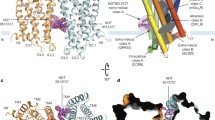Abstract
The anti-inflammatory drug, PMX205, is an antagonist of the C5a complement receptor and has been shown to be effective in rodent models of amyotrophic lateral sclerosis and Alzheimer’s disease. This cyclic hexapeptide (c[Arg-Trp-D-Cha-Pro-Orn]-Hca) has been reported to produce relatively low yields for both the linear peptide assembly and the cyclization reaction in solution and solid phase syntheses. During attempts to reproduce the solid phase methodology, a catastrophic loss of substitution was encountered which could be avoided or reduced by the use of 2-chlorotrityl resin. Likewise, the cyclization reaction could be significantly improved by the use of FDPP (pentafluorophenyl diphenylphosphinate) at high dilution (up to 80% purified yield). Both improvements are accomplished with commercially available products.





Similar content being viewed by others
Abbreviations
- Boc:
-
tert-Butyloxycarbonyl
- COMU:
-
4-[[[(1-cyano-2-ethoxy-2-oxoethylidene)amino] oxayl](dimethylamino)methylene]morpholinium hexafluorophosphate
- DBU:
-
1,8-diazabicyclo[5.4.0]undec-7-ene
- D-Cha:
-
D-cyclohexylalanine
- DEAE:
-
Diethylaminoethyl
- Dde:
-
N-(1-(4,4-dimethyl-2,6-dioxocyclohexylidene)ethyl)
- DIPC:
-
Diisopropylcarbodiimide
- DIPEA:
-
N,N-diisopropylethylamine
- DMF:
-
Dimethylformamide
- ESI–MS:
-
Electrospray ionization mass spectroscopy
- FDPP:
-
Pentafluorophenyl diphenylphosphinate
- Fmoc:
-
9-fluorenylmethyloxycarbonyl
- fw:
-
Formula weight
- GC-MS:
-
Gas chromatography mass spectrometry
- HATU:
-
N-[(dimethylamino)-1H-1,2,2-triazolo[4,5-b]pyridine-1-ylmethylene]-N-methylmethanaminium hexafluorophosphate
- Hca:
-
Hydrocinnaminic acid
- HOAt:
-
1-hydroxy-7-azabenzotriazole
- MTBE:
-
Methyl tert-butyl ether
- mw:
-
Molecular weight
- Pbf:
-
2,2,4,6,7-pentamethyl-2,3-dihydrobenzofuran-5-sulfonyl
- PyBOP:
-
Benzotriazol-1-yloxytris(dimethylamino)phosphonium hexafluorophosphate
- RP-HPLC:
-
Reversed phase high performance liquid chromatography
- TFA:
-
Trifluoroacetic acid
References
Abbenante G, Fairlie DP, Reid RC (2007) Process for the preparation of cyclic peptides. US patent 2007/0245926 A1
Ager RR, Fonseca ML, Chu S-H et al (2010) Microglial C5aR (CD88) expression correlates with amyloid-β deposition in murine models of Alzheimer’s disease. J Neurochem 113:389–401
Albericio F, Kneib-Cordonier N, Biancalana S et al (1990) 5-(4-(9-fluorenylmethyloxycarbonyl)aminomethyl-3,5-dimethoxyphenoxy)-valeric acid (PAL) handle for the solid-phase synthesis of C-terminalpeptide amides under mild conditions. J Org Chem 55:3730–3743
Carpenter KA, Weltrowska G, Wilkes BC, Schmidt R, Schiller PW (1994) Spontaneous diketopiperazine formation via end-to-end cyclization of a nonactivated linear tripeptide: an unusual chemical reaction. J Am Chem Soc 116:8450–8458
Carpino LA (1993) 1-Hydroxy-7-azabenzotriazole. An efficient peptide coupling additive. J Am Chem Soc 115:4397–4398
Chan WC, White PD (2004) Basic procedures. In: Chan WC, White PD (eds) Fmoc solid phase peptide synthesis—a practical approach. Oxford University Press, Oxford, pp 41–76
Chen S, Xu J (1991) Pentafluorophenyl diphenylphosphinate a new efficient coupling reagent in peptide chemistry. Tetrahedron Lett 32:6711–6714
El-Faham A, Albericio F (2010) COMU: a third generation of uranium-type coupling reagents. Pept Sci 16:6–9
Fairweather KA, Sayyadi N, Luck IJ, Clegg JK, Joliffe KA (2010) Synthesis of all L-cyclic tetrapeptides using pseudoprolines as removable turn indicators. Org Lett 12:3136–3139
Fields GB (1995) Methods for removing the Fmoc group. In: Pennington MW, Dunn BM (eds) Methods in molecular biology, vol 35. Springer Protocols, Humana Press, New York, pp 17–27
Fonseca ML, Ager RR, Chu S-H et al (2009) Treatment with a C5aR antagonist decreases pathology and enhances behavioral performance in murine models of Alzheimer’s disease. J Immunol 183:1375–1383
Kaiser E, Colescott RL, Bossinger CD, Cook PI (1970) Color test for detection of free terminal amino groups in the solid-phase synthesis of peptides. Anal Biochem 34:595–598
Kaiser E, Bossinger CD, Colescott RL, Olsen DB (1980) Color test for terminal prolyl residues in the solid-phase synthesis of peptides. Anal Chim Acta 118:149–151
Köhl J (2006) Drug evaluation: the C5a receptor antagonist PMX53. Curr Opin Mol Ther 8:529–538
Lawhon C (2009) Drug rescues memory lost to Alzheimer’s disease. U.C. Irvine Communications: UCIrvine Today, July 14, 2009
Mellor SL, Wellings DA, Fehrentz J-A et al (2004) Synthesis of modified peptides. In: Chan WC, White PD (eds) Fmoc solid phase peptide synthesis—a practical approach. Oxford University Press, Oxford, pp 137–181
Pedroso E, Grandas A, de las Heras X, Eritja R, Giralt E (1986) Diketopiperazine formation in solid phase peptide synthesis using p-alkoxybenzyl ester resins and Fmoc amino acids. Tetrahedron Lett 27:743–746
Reid R, Abbenante G, Taylor SM, Fairlie DP (2003) A convergent solution phase synthesis of the macrcocycle Ac-Phe-[Orn-Pro-D-Cha-Trp-Arg], a potent new antiinflammatory drug. J Org Chem 68:4464–4471
Woodruff TM, Constantini KJ, Crane JW et al (2008) The complement factor C5a contributes to pathology in a rat model of amyotrophic lateral sclerosis. J Immunol 181:8727–8734
Acknowledgments
We are grateful to the National Institutes of Health (NINDS, NS35144, A.J. Tenner, PI) for partial support (to ARC) of this work. We thank J. Greaves and S. Sorooshian of the UCI Mass Spectrometer Facility for assistance and C.G. Glabe for his support.
Author information
Authors and Affiliations
Corresponding author
Rights and permissions
About this article
Cite this article
deLisle Milton, R.C., Milton, S.C. & Chamberlin, A.R. Improving the Fmoc Solid Phase Synthesis of the Cyclic Hexapeptide Complement C5a Antagonist, PMX205. Int J Pept Res Ther 17, 337 (2011). https://doi.org/10.1007/s10989-011-9273-9
Accepted:
Published:
DOI: https://doi.org/10.1007/s10989-011-9273-9




